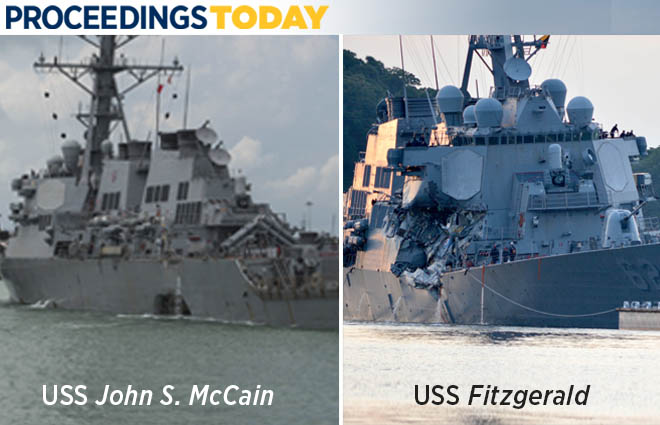
We do not yet know the causes of the USS John S. McCain (DDG-56) and USS Fitzgerald (DDG-62) collisions that resulted in the death of 17 sailors. It is likely, however, that technical failure played little or no role.
Despite some differences (John S. McCain was hit on the port side, Fitzgerald on the starboard), the similarities are many. The automatic identification system (AIS), which publicly transmits ship position, course, and speed, indicated that both merchant ships had been on essentially steady courses and speeds for the hour immediately preceding each collision. Each collision occurred on the midwatch (0524 and 0130, respectively), during good visibility, and with the captain absent from the bridge. In both cases the merchant hit the Navy ship, which likely means the warship was crossing ahead of the merchant.
In neither case were significant navigational system degrades present, although it has been reported that the John S. McCain suffered a steering casualty just before the collision.
Both warships have multiple ways to detect other ships, including monitoring AIS, radars, sonar, and the lookouts’ eyesight. This is why we hypothesize that both warships had information that they were standing into danger, which, if acted upon, would have avoided the collisions.
With that hypothesis in mind, the following are three areas of inquiry for the Navy investigators:
• What were the barriers to speaking up at the operator level? If there was information on the warship and it was known to operators, did they voice it? If they kept it to themselves, what got in the way of their speaking up? Specifically, the question to be answered is what were the organizational and cultural factors that presented obstacles to saying something. This should not be an investigation into the performance or character flaws of the particular operator; this is an inquiry into the practices around expressing dissenting and differing opinions.
• What were the barriers to taking action at the officer level? If information was voiced, why was it dismissed or not acted upon? To what degree was there a bias against action by the bridge teams, as evidenced by their day-to-day interactions with the captain? The investigation should examine the language used among the officers and between the teams and the captains. The mindset of decision-makers relative to performance goals should be probed. Was their objective to achieve excellence—what psychologists call a performance-approach mindset—or was it to avoid errors, which psychologists call a performance-avoid mindset? Understanding this is important, because studies have correlated performance-avoid mindsets with worse outcomes. This is an inquiry into the practices around initiative and action.
• What were the barriers to certification at the command level? The Navy has a process for readiness that requires the captain and the commodore to certify that the ship is ready to deploy. The question is how rigorous are those certifications, and how many of the previous ones resulted in failures. How often in the past three years, for example, were ships delayed in deploying because of inadequacies in training readiness? No certifying officer wants to rush a ship out on deployment that isn’t ready, but reporting up the Navy chain that a ship will not make a deployment date is also embarrassing and comes at a cost to professional reputation. If ships never fail certification then this step is simply another performance step preceding deployment. This is an inquiry into the practices of speaking truth to power.
The example of the cargo ship El Faro may be instructive to investigators. On 30 September 2015, El Faro departed Jacksonville, Florida, bound for Puerto Rico with tropical storm Joaquin building. The next day, 1 October 2015, Joaquin was upgraded to a category 3 hurricane. The El Faro failed to divert sufficiently and steamed into 40-foot seas. She was lost at sea that day with all 33 souls.
The motto of TOTE Maritime, the shipping company that owned El Faro, was “on time, every time.” There was a strong culture and expectation to complete the mission and push through adversity. The captain was known to be under evaluation for his performance as the company transitioned to a newer line of ships. This combination of factors likely affected his calculus when deciding whether to turn around to avoid the storm.
The thrust of the three areas of inquiry listed here is to see if Navy crews, like the El Faro crew, are trapped in production work. It is natural to want to do our jobs well, and we don’t want to feel like failures. We don’t want to tell our bosses we can’t do something. This is particularly true for the men and women of the U.S. Navy, which is a can-do organization. Unfortunately, this dedication to doing can result in a must-do attitude that sometimes clouds judgment. That is worth investigating.
Captain Marquet retired from the Navy in 2009 after 28 years and now promotes Intent-Based Leadership, an approach he developed while in command of the USS Santa Fe (SSN-763). Among his other assignments, he served as head of the Pacific Tactical Readiness Evaluation Team and as Commander, Submarine Squadron 3. He graduated with distinction from the U.S. Naval Academy in 1981, is a life member of the Council on Foreign Relations, and authored the book Turn the Ship Around: A True Story of Turning Followers into Leaders (2013).
For more on the cultural aspects of the recent Navy collisions, read this article.


